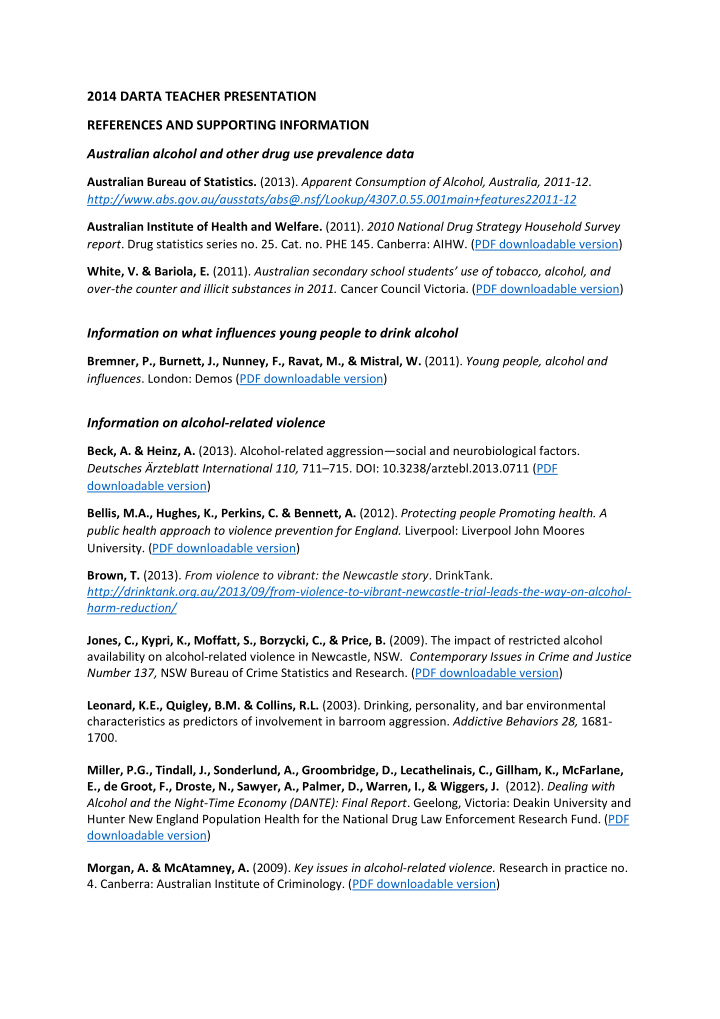



2014 DARTA TEACHER PRESENTATION REFERENCES AND SUPPORTING INFORMATION Australian alcohol and other drug use prevalence data Australian Bureau of Statistics. (2013). Apparent Consumption of Alcohol, Australia, 2011-12. http://www.abs.gov.au/ausstats/abs@.nsf/Lookup/4307.0.55.001main+features22011-12 Australian Institute of Health and Welfare. (2011). 2010 National Drug Strategy Household Survey report . Drug statistics series no. 25. Cat. no. PHE 145. Canberra: AIHW. (PDF downloadable version) White, V. & Bariola, E. (2011). Australian secondary school students’ use of tobacco, alcohol, and over-the counter and illicit substances in 2011. Cancer Council Victoria. (PDF downloadable version) Information on what influences young people to drink alcohol Bremner, P., Burnett, J., Nunney, F., Ravat, M., & Mistral, W. (2011). Young people, alcohol and influences . London: Demos (PDF downloadable version) Information on alcohol-related violence Beck, A. & Heinz, A. (2013). Alcohol-related aggression — social and neurobiological factors. Deutsches Ärzteblatt International 110, 711 – 715. DOI: 10.3238/arztebl.2013.0711 (PDF downloadable version) Bellis, M.A., Hughes, K., Perkins, C. & Bennett, A. (2012). Protecting people Promoting health. A public health approach to violence prevention for England. Liverpool: Liverpool John Moores University. (PDF downloadable version) Brown, T. (2013). From violence to vibrant: the Newcastle story . DrinkTank. http://drinktank.org.au/2013/09/from-violence-to-vibrant-newcastle-trial-leads-the-way-on-alcohol- harm-reduction/ Jones, C., Kypri, K., Moffatt, S., Borzycki, C., & Price, B. (2009). The impact of restricted alcohol availability on alcohol-related violence in Newcastle, NSW . Contemporary Issues in Crime and Justice Number 137, NSW Bureau of Crime Statistics and Research. (PDF downloadable version) Leonard, K.E., Quigley, B.M. & Collins, R.L. (2003). Drinking, personality, and bar environmental characteristics as predictors of involvement in barroom aggression. Addictive Behaviors 28, 1681- 1700. Miller, P.G., Tindall, J., Sonderlund, A., Groombridge, D., Lecathelinais, C., Gillham, K., McFarlane, E., de Groot, F., Droste, N., Sawyer, A., Palmer, D., Warren, I., & Wiggers, J. (2012). Dealing with Alcohol and the Night-Time Economy (DANTE): Final Report . Geelong, Victoria: Deakin University and Hunter New England Population Health for the National Drug Law Enforcement Research Fund. (PDF downloadable version) Morgan, A. & McAtamney, A. (2009). Key issues in alcohol-related violence. Research in practice no. 4. Canberra: Australian Institute of Criminology. (PDF downloadable version)
Quigley, B.M. & Leonard, K.E. (2005). Alcohol use and violence among young adults . http://pubs.niaaa.nih.gov/publications/arh284/191-194.htm Rossow , I., Bogstrand, S.T., Ekeberg, O., & Normann, P.T. Associations between heavy episodic drinking and alcohol related injuries: a case control study. BMC Public Health 13 : 1076. (PDF downloadable version) Shepherd, J., Bellis, M.A., Hughes, K., & Stewart, L. (2005). Alcohol and violence: Briefing statement. Faculty of Public Health of the Royal College of Physicians of the United Kingdom. (PDF downloadable version) The City of Newcastle. (2010). Safe Newcastle – Alcohol Management Strategy. Newcastle: The City of Newcastle. (PDF downloadable version) Wells, S., Graham, K., Tremblay, P.F., & Magyarody, N. (2011). Not just the booze talking: Trait aggression and hypermasculinity distinguish perpetrators from victims of male barroom aggression. Alcoholism: Clinical and Experimental Research 35, 613 – 620. World Health Organisation. (2006). Youth violence and alcohol. (PDF downloadable version) Information on alcohol and the developing brain Ackerman, S. (2007). The Adolescent Brain – The Dana Guide. https://www.dana.org/news/brainhealth/detail.aspx?id=10056 Arain, M., Haque, M., Johal, L., Mathur, P., Nel, W., Rais, A., Sandhu, R., & Sharma, S. (2013). Maturation of the adolescent brain. Neuropsychiatric Disease and Treatment 9 , 449-461. doi: 10.2147/NDT.S39776. (PDF downloadable version) Brainwave Trust. (2012). The adolescent brain and alcohol. Brainwave Trust Aotearoa. (PDF downloadable version) Government of Western Australia . (2012). Alcohol and the developing brain. http://alcoholthinkagain.com.au/Alcohol-Related-Information/What-Young-People-Need-To- Know/Alcohol-And-The-Developing-Brain.aspx Hickie, I. & Whitwell, B.G . (2009). Alcohol and the teenage brain: Safest to keep them apart . BMRI Monograph 2009-2. Sydney: Brain and Mind Institute. (PDF downloadable version) National Institute of Mental Health. (2011). The Teen Brain: Still Under Construction. US Department of Health and Human Services. (PDF downloadable version) Squeglia, L.M., Jacobus, J. & Tapert, S.F. (2009). The influence of substance use on adolescent brain development, Clinical EEG Neuroscience 40, 31 – 38. (PDF downloadable version) Turning Point Inc. (2012). Under construction . http://www.youtube.com/watch?v=g2gVzVIBc_g Information on alcohol and cancer Cancer Council of Australia. (2013). Position Statement: Alcohol and cancer prevention. http://wiki.cancer.org.au/prevention/Position_statement_-_Alcohol_and_cancer
Information on alcohol and GABA Gowin, J. (2010). Your brain on alcohol . http://www.psychologytoday.com/blog/you- illuminated/201006/your-brain-alcohol Hiller-Sturmhöfel, S. & Scott Swartzwelder, H.S. (no date provided). Alcohol’s effects on the adolescent brain — What can be learned from animal models ? National Institute on Alcohol Abuse and Alcoholism. http://pubs.niaaa.nih.gov/publications/arh284/213-221.htm Information on parenting style and impact on alcohol and other drug use Bartlett, J., Grist, M. & Hahn, B. (2011). Under the influence. London: Demos (PDF downloadable version) Gilligan, C., Kypri, K., Johnson, N., Lynagh, M., & Love, S. (2012). Parental supply of alcohol and adolescent risky drinking. Drug and Alcohol Review 31, 754-762. Piko, B.F. & Balazs, M.A. (2012). Authoritative parenting style and adolescent smoking and drinking. Addictive Behaviors 37, 353-356. Piko, B.F. & Kovacs, E. (2010). Do parents and school matter? Protective factors for adolescent substance use. Addictive Behaviors 35, 53-56. Toumbourou, J.W., Gregg, M.E., Shortt, A.L., Hutchinson, D.M., & Slaviero, T.M. (2013). Reduction of adolescent alcohol use through family-school intervention: A randomized trial. Journal of Adolescent Health 53, 778-784. Van Hoof, J.J., Van den Boom, S.G.M. & De Jong, M.D.T. (2011). Making sense of alcohol experiences. Young adolescents’ accounts of alcohol -related critical incidents. Addictive Behaviors 36, 849-854. COMMUNITY ACTION AND ADVOCACY GROUPS Last Drinks – a campaign from organisations representing emergency services workers in NSW challenging the 24/7 drinking culture (www.lastdrinks.org.au) Community Alcohol Action Network (CAAN) a program of the Australian Drug Foundation (ADF) which encourages people to take action to reduce alcohol-related problems and harms within their own circles (www.adf.org.au/policy-advocacy/community-alcohol-action-network). You can also subscribe to the GrogWatch blog that provides a regular on-line forum for the exchange of information and opinion on alcohol matters of topical interest
Recommend
More recommend